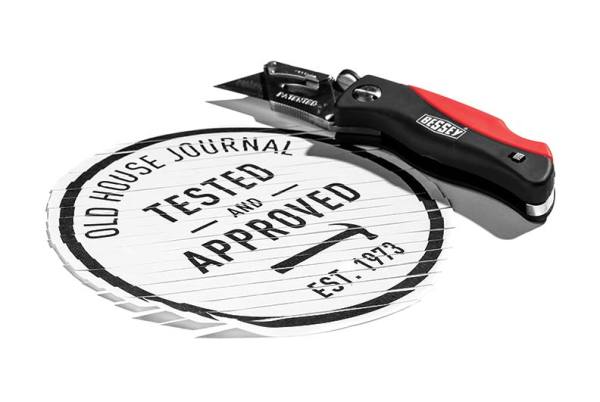Ever since Stanley introduced the No. 199 utility knife in the mid-1930s, this simple tool has been a staple of every toolbox. That first fixed-blade knife is still available, but in the decades since, manufacturers have gone to great lengths to produce and market knives that are effective, safe, and convenient.

The utility knife’s varied applications are almost endless. A few that make this such an invaluable tool for old-house owners include cutting the paint film between a window sash and the stop molding to free up sash; cutting failing glazing compound to remove a pane of glass; scoring and cutting wooden (or even asphalt) shingles to width; scoring, bending, and breaking thin sheet metal flashing; trimming wallpaper; removing old caulk; and cleaning out the paint-clogged slots of old over-painted screws.
Over the years, advancements in knife design include the retractable blade, the tool-less blade change, and convenient storage of additional blades in the handle. The most recent evolution is the folding utility knife. For the most part, this eliminated the safety demand for a retractable blade and made the tool easy to pocket. Once unfolded, they are similar in size to standard utility knives with many (or more) of the features that make them so valuable. The folding utility knife adds convenience, safety, and ergonomics to an old standby.
Utility Knife Test
Wiss WKF1
With a smaller profile, the Wiss knife was popular with our female testers, though men generally found it less comfortable. Several testers pointed out its less-than-smooth open-close mechanism: “It required both hands and felt like it was making me bring my hands too close to the blade,” commented contractor Nick Tenaglia. The lowest-priced knife in our test, the Wiss doesn’t come with many special features (such as blade storage), but overall, our testers agreed it’s a good, sturdy basic knife.
Olympia 33-200
The trademark of this knife seems to be its ability to lock open in three positions, which confounded our testers: “I found the multiple folding positions to carry more potential for injury than possible benefit,” said contractor Tom McPoyle. Most also noticed some play in the blade—another cause for concern. However, the blade-change mechanism (controlled by a dial on the top of the knife) received plenty of raves: “It was easy and even fun to change blades on this knife,” said DIYer Jude Herr.
DeWalt DWHT10261
The only retractable knife in our test got mixed reviews. Testers liked the safety and flexibility afforded by the retractable blade, and most found the auto-loading blade-change mechanism easy to use. However, ergonomics proved to be its downfall—while testers conceded that the rubber grip on top of the knife improved comfort and accuracy, most were turned off by its hefty weight and mostly metal body. “The metal edges on the inside of the handle made for an uncomfortable grip,” said McPoyle.
Bessey D-BKPH
Our testers praised this knife’s comfortable rubber grip and oversized thumb pad: “Nothing is in an awkward spot, even for a left-handed user,” said contractor Christine Cookish. A sturdy belt clip and a storage chamber that can hold up to five extra blades also won praise. However, the knife’s complicated blade-change mechanism knocked it down a few pegs: “It takes two awkward movements to release the blade, and I never felt totally safe doing it,” said DIYer Juan Aviles.
Milwaukee Fastback II
With an unexpectedly comfortable grip and loads of special features (including a magnetized storage chamber, a wire stripper, and a gut hook), the Milwaukee knife had no trouble garnering rave reviews. “I was surprised that the all-metal body could be contoured to produce a grip that is this comfortable,” said our expert, Ray Tschoepe. As the only knife in the test that could be opened and closed with one hand, it got extra points for ease of use. The push-button blade-change mechanism was another plus.
Pro Tip
Anytime you reach for a utility knife, bear in mind that you should use the razor-sharp blade with caution. Remember to wear eye protection and cut-resistant gloves. Make sure the blade is properly seated. Plan your cuts so the blade isn’t moving toward you or someone else. Take your time—several passes with moderate pressure are better than a single cut with heavy pressure. Change blades frequently, since sharp blades are safer than dull ones. Finally, never pry anything with the blade. They are strong but brittle, and can snap and fly easily.
–Ray Tschoepe, Director of Conservation, Fairmount Park Historic Preservation Trust







